Abstract
Paraffin injection has been widely used to improve body contouring or to augment various body parts, although it has now been abandoned owing to serious complications. Paraffin injection may lead to complications after a long latency period, ranging from several years to several decades. Here, we present the rare case of a 77-year-old woman who suffered from recurrent wound problems after a bilateral paraffin injection into her hands 40 years ago. Initially, conservative debridement was carried out due to the patient’s reluctance to undergo extensive surgery and cost concerns. However, this resulted in recurrent wound dehiscence and infection. After serial debridement procedures, a skin graft was performed on her right hand. The patient complained of a depressed contour and numbness at the skin graft site, and tightness and discomfort of her right hand during flexion of the metacarpophalangeal joint. Three years later, the patient presented with a highly similar wound on her left hand. Thorough excision of the soft tissue infiltrated by paraffin was performed, followed by reconstruction using a sensate free anterolateral thigh flap. The patient responded well postoperatively without complications, displaying a fair range of motion without discomfort, sensory restoration of the flap, and satisfaction with the contour of the dorsum. This case report highlights the importance of complete excision of soft tissues infiltrated by paraffin for definitive treatment. Among the various reconstruction options, a sensate free flap is a good choice for achieving favorable functional and esthetic outcomes in hand reconstruction after radical excision of a paraffinoma.
Foreign body injections such as silicone, vaseline, and paraffin have been commonly used to improve body contouring or to augment various body parts [1,2]. Paraffin injection has been frequently reported in penis and breast augmentation, and although less common, it has also been reported for cosmetic contouring of the face, limbs, and labia [2-6]. Given its simplicity, affordability, relative painlessness, and immediately positive esthetic outcome, it was frequently employed by numerous nonmedical practitioners [2,4,5].
Although paraffin injection was widely used for cosmetic purposes for a long time, it has now become an abandoned procedure due to serious complications. Complications from paraffin injection can range from a painless lump to ulceration and necrosis, and even cancer and mortality [3,7-9]. Generally, most cases do not exhibit any noticeable symptoms initially; however, in some cases, an immediate inflammatory reaction may occur. Over time, as a foreign body reaction and fibrosis progress within the body, the formation of a paraffinoma occurs, leading to various complications mentioned earlier. Due to these reasons, complications may arise after a long latency period, ranging from several years to, in some cases, several decades [5]. The definitive treatment for these patients includes the radical and complete excision of soft tissue infiltrated by paraffin [2,10].
To the best of our knowledge, paraffin injection to the hand is extremely rare [11]. Here, we present the rare case of a 77-year-old woman who suffered from recurrent wound problems after a bilateral paraffin injection into her hand dorsum 40 years ago.
This study was approved by the Institutional Review Board of Seoul National University College of Medicine and Seoul National University Hospital (No. H-2405-033-1534).
A 77-year-old woman with underlying diabetes and hypertension was referred to our clinic with a recurrent wound problem in the dorsum of her right hand that started 1 year ago. The patient had received a bilateral paraffin injection from a nonmedical practitioner to her hand dorsum approximately 40 years ago. She presented with a 1 cm-sized ulcerative lesion without any active discharge, along with swelling, mild redness, and firm changes on the entire dorsum of her right hand (Fig. 1). Both hands exhibited a metacarpophalangeal joint flexion limitation of up to 40° in both passive and active flexion. The patient reported no subjective discomfort in her hand motion and function. Magnetic resonance imaging revealed diffuse soft tissue thickening with multiple microcystic fatty components in the dorsum of the right hand, located on the outer side of the extensor digitorum communis tendon that coincided with the paraffinoma (Fig. 2).
First, we recommended a radical excision of the soft tissue infiltrated by paraffin, and hand reconstruction using a free flap. However, the patient expressed a strong reluctance towards extensive surgery because of concerns about the resulting large scar and the substantial cost of the procedure that would not be covered by health insurance. The patient ultimately opted for conservative debridement, followed by primary closure (Fig. 3). Surgical findings revealed a firm mass with severe adhesion to the paratenon of the extensor tendon. The results from a histopathological examination showed vacuolated foreign materials in the fibroadipose tissue with hyaline sclerosis, consistent with a diagnosis of paraffinoma (Fig. 4). After the initial operation, recurrent wound dehiscence, and wound infection occurred due to compromised skin perfusion. Intravenous antibiotic infusion and serial wound debridement were performed until a clean wound bed was formed and healthy granulation tissue grew. Approximately 6 months after the initial visit, the dorsum of the hand was reconstructed using a full-thickness skin graft (Fig. 5). The patient showed almost the same range of motion as at her initial visit, except for a limitation in the active extension of the ring finger metacarpophalangeal joint, with an extension lag of approximately 10°. However, the patient complained of tightness and discomfort in the dorsum of her right hand during the flexion of the metacarpophalangeal joint. In addition, the patient was dissatisfied with the depressed contour and numbness of the dorsum of her right hand.
Three years later, the patient presented with a 2 cm-sized ulcer with swelling, redness, and firm changes on the dorsum of her left hand (Fig. 6). A thorough excision of the soft tissue infiltrated by paraffin and reconstruction using a free flap were planned. To reconstruct the hand dorsum, we decided to use a thin pliable flap to match the contour, chose a sensate flap for sensory recovery, and elevated it along the subfascial plane to minimize the extensor digitorum communis tendon gliding disruption. The extent of excision was determined preoperatively with a 1-cm margin from hardened soft tissue on the dorsum of the left hand and adjusted based on intraoperative findings to ensure the thorough removal of paraffin-infiltrated soft tissue. Radical excision was performed, including the entire affected dorsum skin and soft tissue. The extensor tendons were preserved and the affected paratenon was excised (Fig. 7). A 9×10.5 cm-sized anterolateral thigh fasciocutaneous flap including the lateral femoral cutaneous nerve was harvested. The flap artery and vein were anastomosed to the radial artery and dorsal vein, respectively. Additionally, end-to-side neurorrhaphy of the flap nerve to the superficial branch of the radial nerve was performed. The patient showed a good postoperative course without complications, with a fair range of motion without tightness or discomfort and was satisfied with the contour of the flap. (Figs. 8, 9). Initially, flexion of the metacarpophalangeal joint was limited up to 40° in both passive and active, but it improved with active flexion reached up to 55°–60° and passive flexion was possible up to 70°, 2 months after the surgery. Also, the patient reported a subjective sensory score of 2 points out of 10 for the flap 2 months after the operation.
Paraffin was one of the most commonly used foreign body materials that were injected into various body parts to improve the body contour esthetically or for augmentation. Most reports of paraffin injection into the body involve cases related to the penis and breasts [2-5].
Owing to its high complication rate and the occurrence of serious complications, the once widely used paraffin injection intervention is now considered an abandoned and obsolete procedure. Complications from paraffin injection vary depending on the injection site and can range from a painless lump to ulceration and necrosis, and even cancer and mortality [3,7-9]. The most common complications are soft tissue and skin complications. According to a literature review on breast paraffinoma conducted by Yen et al. [5], the most prevalent symptom was a painless lump that occurred in 65.5% of patients. They also reported painful lumps in 14.7% of patients, ulcers in 7.3%, axillary lymphadenopathy in 3.4%, skin discoloration in 2.4%, sinus or fistula in 1.7%, abscess in 1.0%, and nipple retraction in 0.9% of patients. In their literature review on penile paraffinoma, Downey et al. [3] reported that 30.2% of patients presented with penile pain and swelling, 15.4% had ulceration or a fistula, 11.4% had penile deformity, 4.6% had skin necrosis, while 2.7% displayed inguinal lymphadenopathy. They also reported that squamous cell carcinoma was associated with penile paraffinoma. In addition, there have been many reports of breast cancer associated with breast paraffinoma [8,9]. Severe complications such as hypercalcemia, nephrocalcinosis, vessel erosion, and mortality associated with cerebral or pulmonary embolisms have also been reported [2,9,13-15].
The clinical course after paraffin injection has been well described. An acute inflammatory response occurs immediately after paraffin injection. Acute inflammatory complications can occur when large amounts are injected. Otherwise, the inflammatory response diminishes gradually over time and is often followed by a latent phase [2]. Histologically, after the initial inflammatory phase, a chronic response to paraffin oil emerges, initiating a macrophagic reaction that breaks down and assimilates paraffin drops within the cytoplasm in an attempt to metabolize them. Stromal fibroblasts are triggered to generate collagen fibers and isolate the vacuoles containing paraffin oil. Fat tissue calcification and hyaline sclerosis also occur owing to the binding of fatty acids to calcium. As the initial acute inflammatory response transitions into a chronic state, the condition known as sclerosing lipogranuloma is observed [2,16]. The same histological features are observed in the pathological specimens as described above (Fig. 4).
Complications after paraffin injection usually present late, with a long latency period [5]. Lee et al. [17] noted that the mean duration between paraffin injection and symptom onset in penile paraffinoma was 18.5 months. Yen et al. [5] reported latency periods in breast paraffinoma ranging from 2 to 50 years, with an average of 19.1 years. In the present case, complications presented after 40 years of latency. Based on our case and previous reports, even though paraffin injection procedures were discontinued in the late 1900s, there may still be a sufficient number of patients presenting with issues owing to the long latency period associated with this practice.
Although paraffin injection into various body parts has been reported, cases of paraffin injection into the hands are extremely rare. Kwon et al. [11] reported acute inflammatory complications following paraffin injections into hands. In their case report, the patient showed an acute inflammatory reaction 3 days after paraffin injection. The patient was treated with incision and drainage and 5 days of intravenous steroid therapy. Our patient presented with skin ulceration as a chronic complication 40 years after the paraffin injection. We performed extirpation of the entire affected soft tissue infiltrated by paraffin followed by hand reconstruction surgery. To our knowledge, this is the first report of a chronic complication after injection of paraffin into the hands.
The initial acute inflammatory response can be promptly managed with broad-spectrum antibiotics and intravenous steroid therapy. Typically, these symptoms are short-lived and resolve rapidly [4,5]. However, conservative management is usually insufficient for chronic complications that involve the skin and soft tissues. A complete radical excision of the skin and soft tissues infiltrated by paraffin is recommended for definitive treatment in these cases [3,5,6,10]. Our patient underwent conservative management with dressings for the right hand before being referred to our clinic. This initial treatment had proved ineffective, and at our clinic, because of cost concerns and the reluctance of the patient for extensive surgery, we opted for conservative debridement. However, this approach resulted in recurrent and intractable wounds. Due to sclerosis from extensive paraffin infiltration, the dorsum of the hand's soft tissue had compromised circulation and healing potential, making wound excision ineffective and leading to repeated wound dehiscence and infection. Finally, the patient agreed to radical excision of paraffin-infiltrated tissues in the left hand. The procedure was completed in a single stage without any notable complications. Based on this case, it is evident that expectations of recovery from wounds caused by foreign material via dressing treatment or conservative excision alone are ill-placed. Many studies have suggested that complete excision of the infiltrated tissue is crucial for a successful outcome.
After complete excision of the foreign-body-infiltrated tissue, appropriate resurfacing is recommended. Various options can be used to reconstruct hand defects, such as skin grafts, and flaps. When performing hand reconstruction surgery, surgeons should consider hand functions, including sensation and the movement of joints and tendons, in addition to cosmetic appearance [18]. Skin grafting is a simple and effective method of resurfacing. However, the thinness of the skin can result in a depressed contour, and because the skin graft is susceptible to contracture, it can lead to limitations on hand movement. Additionally, skin grafts may result in suboptimal sensory recovery. In our case, the patient complained of depressed contour and numbness of the skin graft site, and tightness and discomfort of the dorsum of her right hand during flexion. Jeong et al. [10] also noted that because of the difficulty in complete excision of foreign body material, the presence of remaining foreign bodies in the wound bed can hinder the use of the skin graft and may lead to the recurrence of issues such as ulceration. Considering these factors, it appears that in such cases, reconstructing the hand using flaps is more favorable than using grafts.
Among the various free flap options, thin, pliable flaps should be considered for contour and characteristic matching of the dorsal skin of the hand. The radial forearm flap has the advantage of being thin, pliable, and similar to dorsal skin characteristics. It also allows for the creation of a sensate flap using the antebrachial cutaneous nerve. However, its main drawback is that the donor site requires a skin graft, which may result in suboptimal esthetics. [18]. The thoracodorsal artery perforator flap also provides a thin, pliable flap with an average thickness of 7.5 mm [19], and a sensate flap using the posterior divisions of the lateral cutaneous branches of the intercostal nerves [20]. However, in the case of our patient, the thick soft tissue on the flank and back did not make it a favored approach. We considered the superficial circumflex iliac artery perforator and anterolateral thigh flaps as final options. In computed tomography images, the estimated thickness of the superficial circumflex iliac artery perforator flap elevated along the superficial fascia plane was 7.0 to 7.4 mm. The estimated thickness of the anterolateral thigh flap elevated along the subfascial plane was 6.1 to 6.6 mm (Fig. 10). The average diameter of the distal radial artery, which would be the recipient artery, is reported as 2.70 mm [21]. The average diameter of the superficial circumflex iliac artery and the descending branch of the lateral circumflex femoral artery is 1.92 and 2.78 mm, respectively [22,23]. In addition, we considered that elevating the superficial circumflex iliac artery perforator flap with the lateral cutaneous branch of the intercostal nerve as a sensate flap would require dissection above the deep fascia instead of the superficial fascia, resulting in increased flap thickness [24]. Considering these factors, we chose the anterolateral thigh flap as the donor. Additionally, anticipating that the flap would be positioned directly above the extensor tendon, we decided to harvest the fasciocutaneous flap. We thought that the fascial component of the flap would contribute to minimizing interference with the gliding of the extensor tendon. The hand dorsum contour match was appropriate, and the patient expressed satisfaction both functionally and esthetically. Owing to the sensate flap transfer, the patient was able to recover the sensation in the dorsum of the left hand. The patient reported a subjective sensory score of 2 points out of 10, 2 months after surgery. Since the follow-up period was short, a complete sensory recovery has not been confirmed as yet. The degree of recovery is not significant due to the short follow-up period; however, in the long term, a more substantial sensory recovery can be anticipated.
Here, we present a rare case of a hand paraffinoma. Paraffin injection into the hand can cause various complications related to the skin and soft tissues, including ulceration and necrosis. Since complications from paraffin injection typically manifest after a long latency period spanning several years to decades, there may still be patients recently presenting with issues related to this practice. When treating these patients, conservative debridement of paraffin-infiltrated tissue may be insufficient and can lead to recurrent wound problems. This case report highlights the importance of a radical and complete excision of soft tissue infiltrated by paraffin for a definitive treatment. Among various reconstruction options, a sensate free flap is a good choice for achieving better functional and esthetic outcomes in hand reconstruction surgery after the radical excision of paraffinoma.
References
1. Boo-Chai K. The complications of augmentation mammaplasty by silicone injection. Br J Plast Surg. 1969; 22:281–5.

2. Di Benedetto G, Pierangeli M, Scalise A, Bertani A. Paraffin oil injection in the body: an obsolete and destructive procedure. Ann Plast Surg. 2002; 49:391–6.

3. Downey AP, Osman NI, Mangera A, Inman RD, Reid SV, Chapple CR. Penile paraffinoma. Eur Urol Focus. 2019; 5:894–8.

4. Ho WS, Chan AC, Law BK. Management of paraffinoma of the breast: 10 years' experience. Br J Plast Surg. 2001; 54:232–4.
5. Yen Kok KY, Tripathi S, Telisinghe P. Breast paraffinoma: an obsolete but still important condition. Experience with 60 cases and the literature review. Asian J Surg. 2023; 46:321–7.
6. Eo SR, Kim KS, Kim DY, Lee SY, Cho BH. Paraffinoma of the labia. Plast Reconstr Surg. 2004; 113:1885–7.

7. Wibowo SA, Wijanarko S, Ismail EA, Putra MD. Total penectomy and perineal urethrostomy management of penile squamous cell carcinoma with paraffinoma in single center hospital: a rare case report. Open Access Maced J Med Sci. 2021; 9(C):55–8.

8. Pennisi VR, Capozzi A, Walsh J, Christensen N. Obscure breast carcinoma encountered in subcutaneous mastectomies. Plast Reconstr Surg. 1971; 47:17–20.

9. Addison PD, Beausang ES, Neligan PC. Malignant fibrous histiocytoma arising in a paraffinoma of the breast. Can J Plast Surg. 2002; 10:215–6.

10. Jeong JH, Shin HJ, Woo SH, Seul JH. A new repair technique for penile paraffinoma: bilateral scrotal flaps. Ann Plast Surg. 1996; 37:386–93.
11. Kwon H, Jung SN, Yim YM. Paraffin injection injury of the hands: presentation and treatment. J Hand Surg Eur Vol. 2009; 34:400–1.

13. Obed D, Krezdorn N, Harik-Chraim E, Freystaetter C, Radtke C, Vogt PM. Complications after liquid body contouring with site-enhancing oil injections. Clin Dermatol. 2022; 40:556–63.

14. Gyldenløve M, Rørvig S, Skov L, Hansen D. Severe hypercalcaemia, nephrocalcinosis, and multiple paraffinomas caused by paraffin oil injections in a young bodybuilder. Lancet. 2014; 383:2098.

15. Pang TC. Death Following Injection of Paraffin into the Breast. Br Med J. 1957; 1:992.
16. Ackerman AB. Histologic diagnosis of inflammatory skin diseases: a method by pattern analysis. Philadelphia, PA: Lea and Febiger;1978.
18. Friedrich JB, Katolik LI, Vedder NB. Soft tissue reconstruction of the hand. J Hand Surg Am. 2009; 34:1148–55.

19. Lee SH, Mun GH. Transverse thoracodorsal artery perforator flaps: experience with 31 free flaps. J Plast Reconstr Aesthet Surg. 2008; 61:372–9.

20. Lin CT, Yang KC, Hsu KC, Liu WC, Chen JS, Chen LW. Sensate thoracodorsal artery perforator flap: a focus on its preoperative design and harvesting technique. Plast Reconstr Surg. 2009; 123:163–74.

21. Wahood W, Ghozy S, Al-Abdulghani A, Kallmes DF. Radial artery diameter: a comprehensive systematic review of anatomy. J Neurointerv Surg. 2022; 14:1274–8.

22. Gholami M, Shaban B, Hejazi A, Sazegar G, Soufizadeh R. Anatomical variations of anterolateral thigh flap: a fresh cadaver dissection study. World J Plast Surg. 2021; 10:18–24.

23. Sinna R, Hajji H, Qassemyar Q, Perignon D, Benhaim T, Havet E. Anatomical background of the perforator flap based on the deep branch of the superficial circumflex iliac artery (SCIP Flap): a cadaveric study. Eplasty. 2010; 10:e11.
Fig. 1.
Initial clinical photographs. The patient presented with a 1-cm ulcerative lesion without any active discharge, along with swelling, mild redness, and firm changes on the entire dorsum of her right hand.
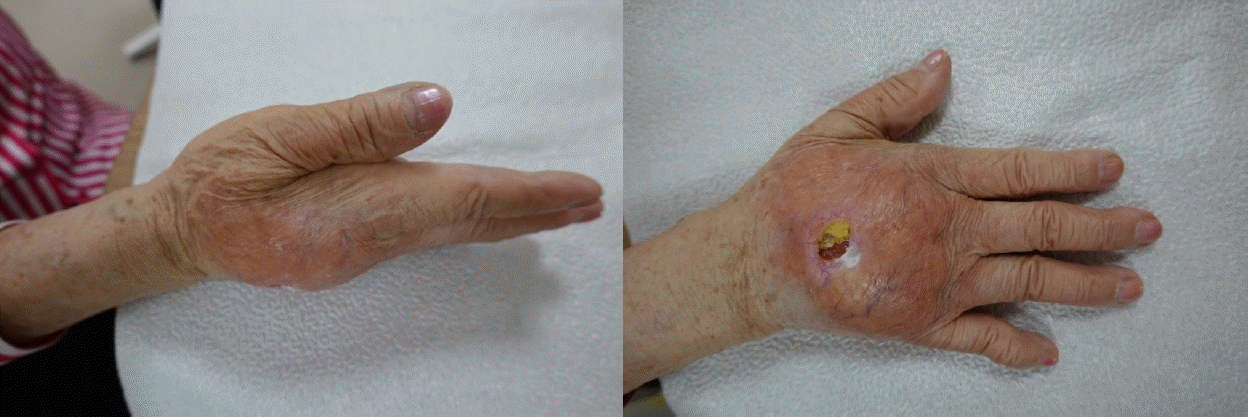
Fig. 2.
Initial magnetic resonance imaging revealed diffuse soft tissue thickening with multiple microcystic fatty components in the dorsum of the right hand, located on the outer side of the extensor digitorum communis tendon.
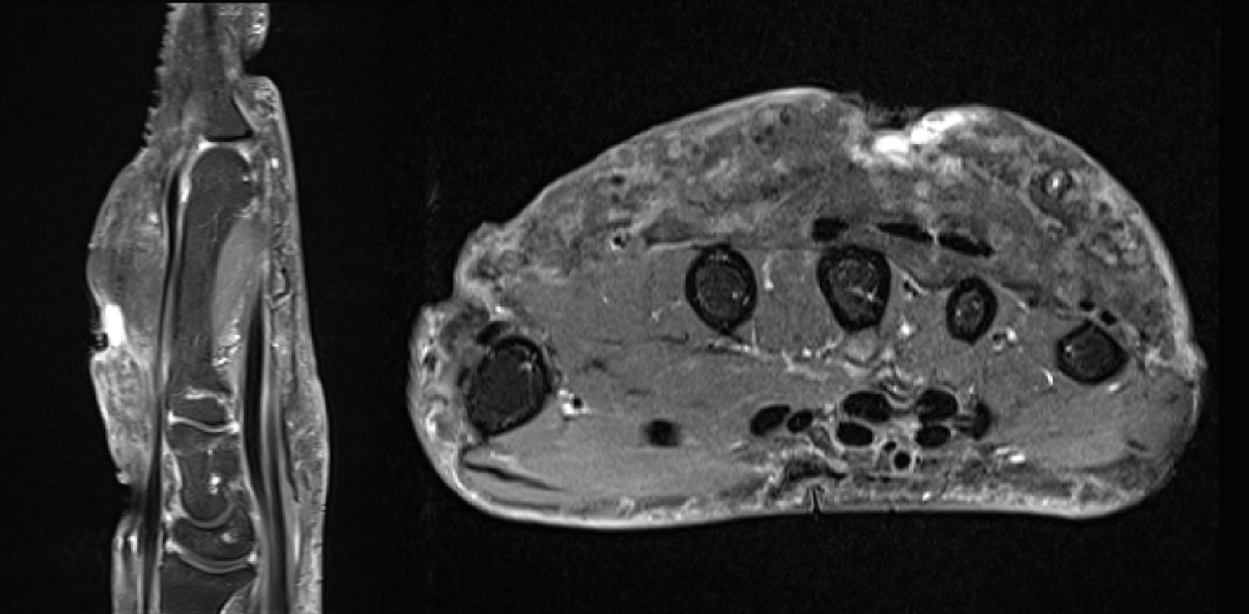
Fig. 3.
Due to the patient’s reluctance to undergo radical excision and reconstruction with a free flap, a conservative debridement leaving a skin flap was performed. The extirpated paraffinoma (A), intraoperative photograph (B), and a postoperative photograph after primary closure (C) are shown.

Fig. 4.
The results from a histopathological examination (H&E stain; A, x40 and B, x100) showed vacuolated foreign materials in the fibroadipose tissue with hyaline sclerosis, consistent with a diagnosis of paraffinoma. Macrophages and fibroblasts surround paraffin oil drops.

Fig. 5.
Clinical photographs during serial debridement. (A–D) The clinical photographs before a full-thickness skin graft (E) and a clinical photograph immediately after the full-thickness skin graft (F).
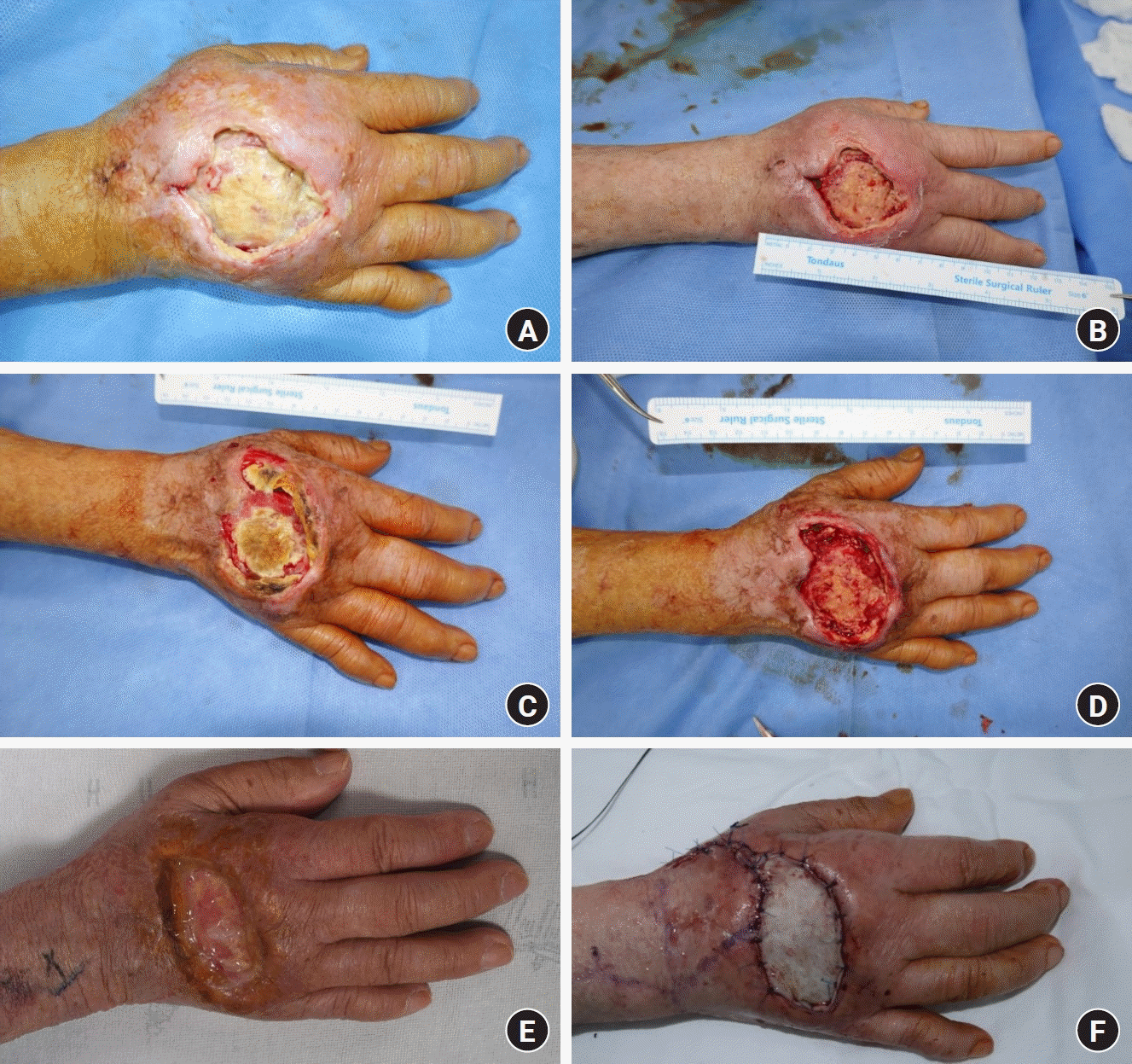
Fig. 6.
Three years later, a similar wound was observed on her left hand. The patient presented with a 2-cm ulcer with swelling, redness, and firm changes on the dorsum of her left hand.
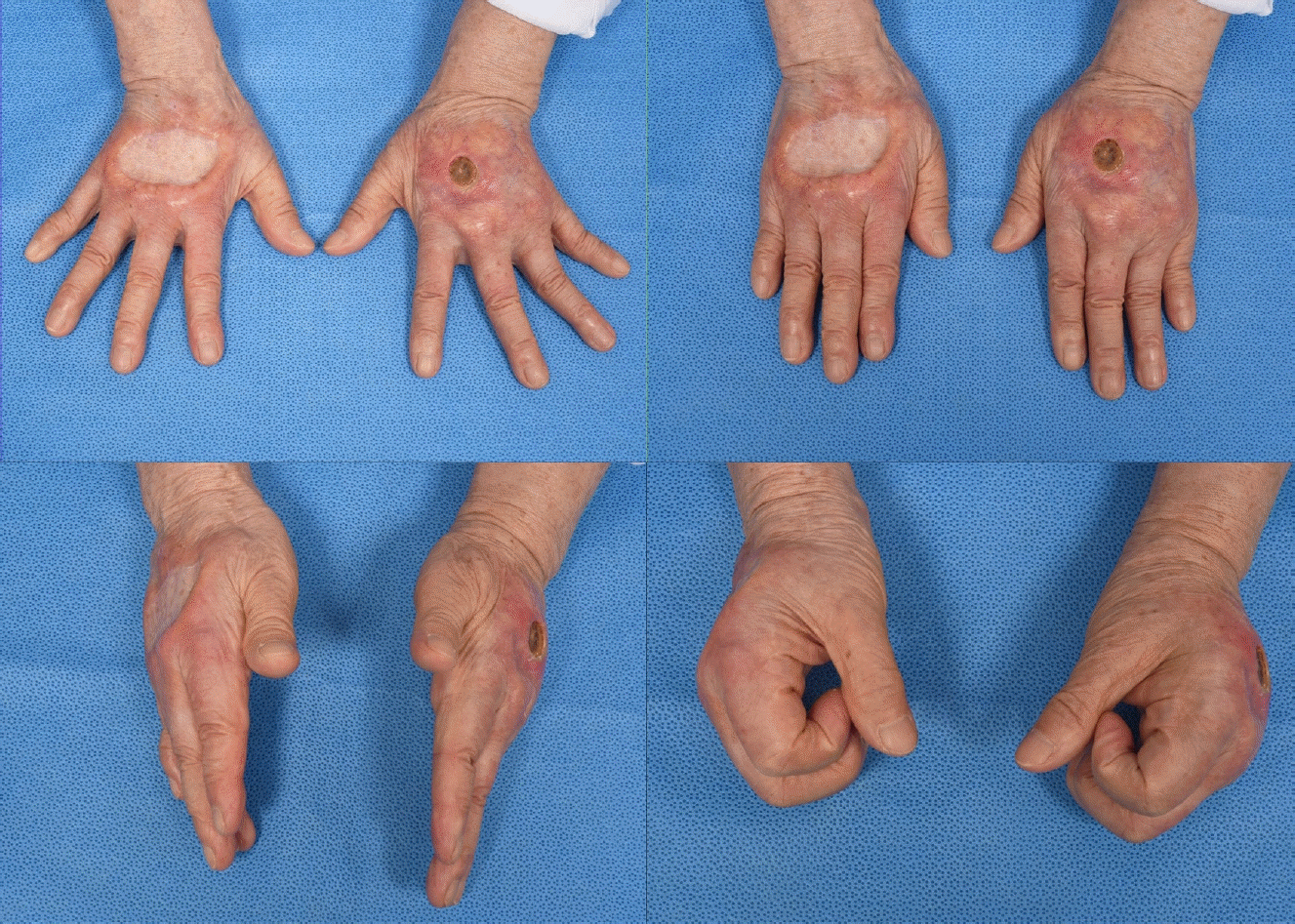
Fig. 7.
Preoperative (A) and intraoperative (B) photographs. A thorough excision of the soft tissue infiltrated by paraffin was performed. The extensor digitorum communis tendons were preserved, and the affected paratenon was excised.





 PDF
PDF Citation
Citation Print
Print




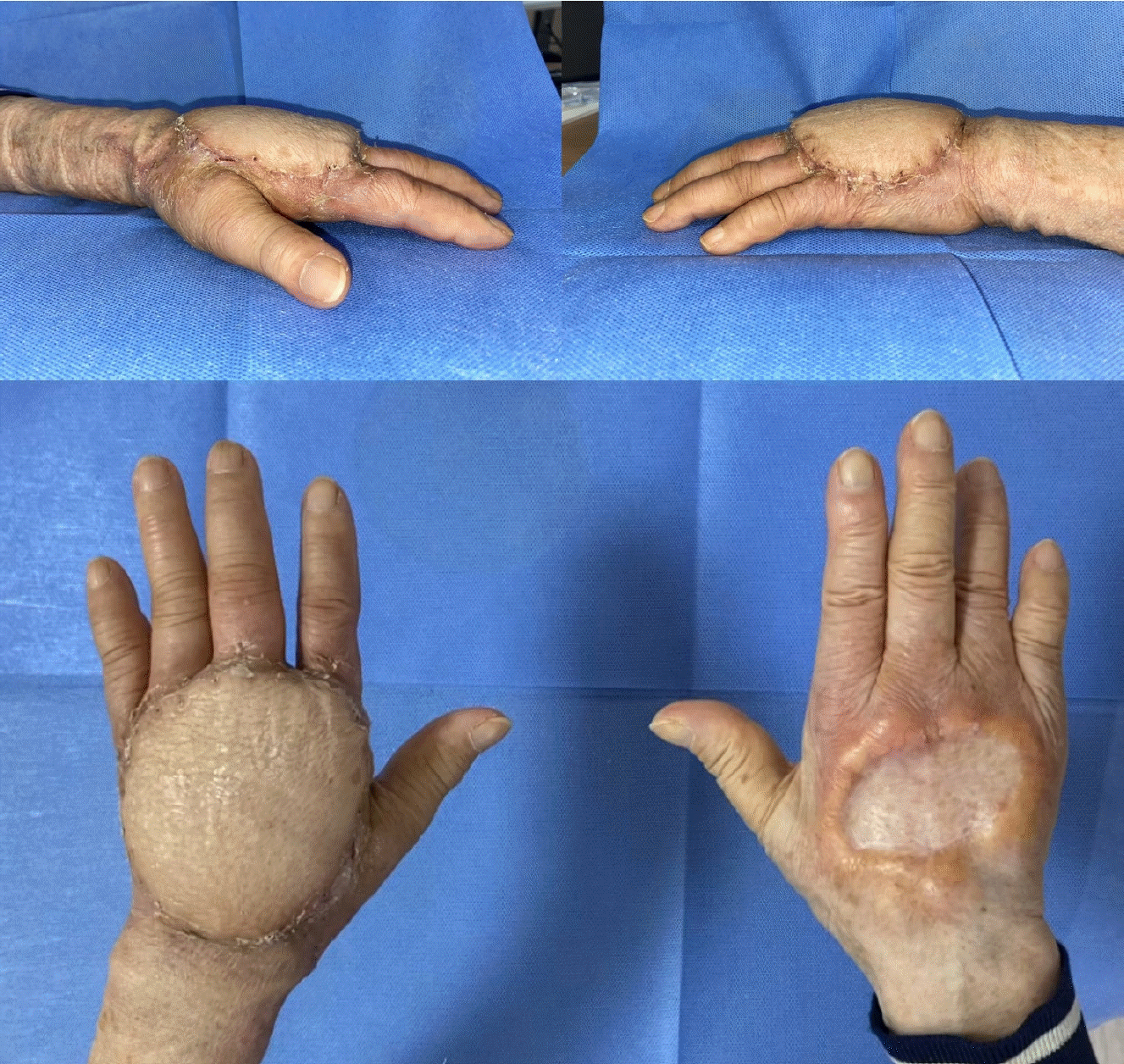
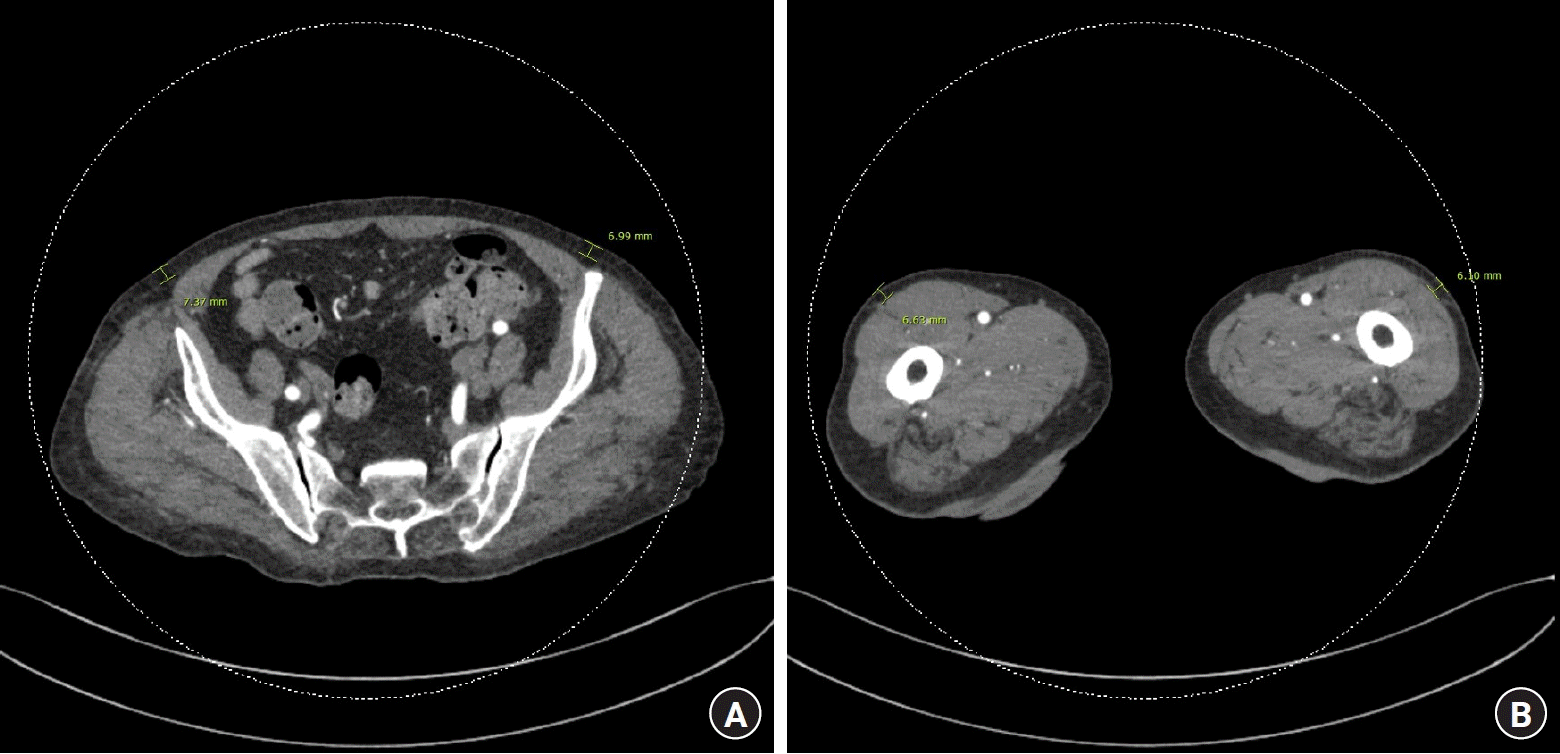
 XML Download
XML Download